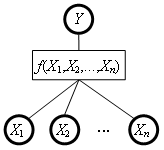Utility Function
Utility functions are the components of multi-attribute models that define the aggregation aspect of option evaluation. For each aggregate attribute Y, whose descendants in the tree of attributes are X1, X2,…, Xn, the corresponding utility function f defines the mapping:
f: X1 × X2 × … × Xn —> Y

In DEXi, a utility function maps all the combinations of the lower-level attribute values into the values of Y. The mapping is represented in a table, where each row gives the value of f for one combination of the lower-level attribute values. Rows are also called decision rules, because each row can be interpreted as an if-then rule of the form:
if X1 = value1 and X2 = value2 and … and Xn = valuen then Y = value (or value interval)
In the context of representation, such rules are also called elementary rules. This name is used for contrast with complex rules.
Example
See utility functions as defined in the Car Evaluation model.
See also
Editing functions with Function Editor and some recommendations on function editing.
Representing utility functions with complex rules and weights.
Avoiding combinatorial explosion and calculating utility function size.
Calculating utility function status measures.
Saving functions on files.